A Nation in Torment
Newsweek Magazine, 3 October 1988.
By Melinda Liu, Asia Regional Editor.
Burma's military ruthlessly crushes its citizens' dreams of democracy
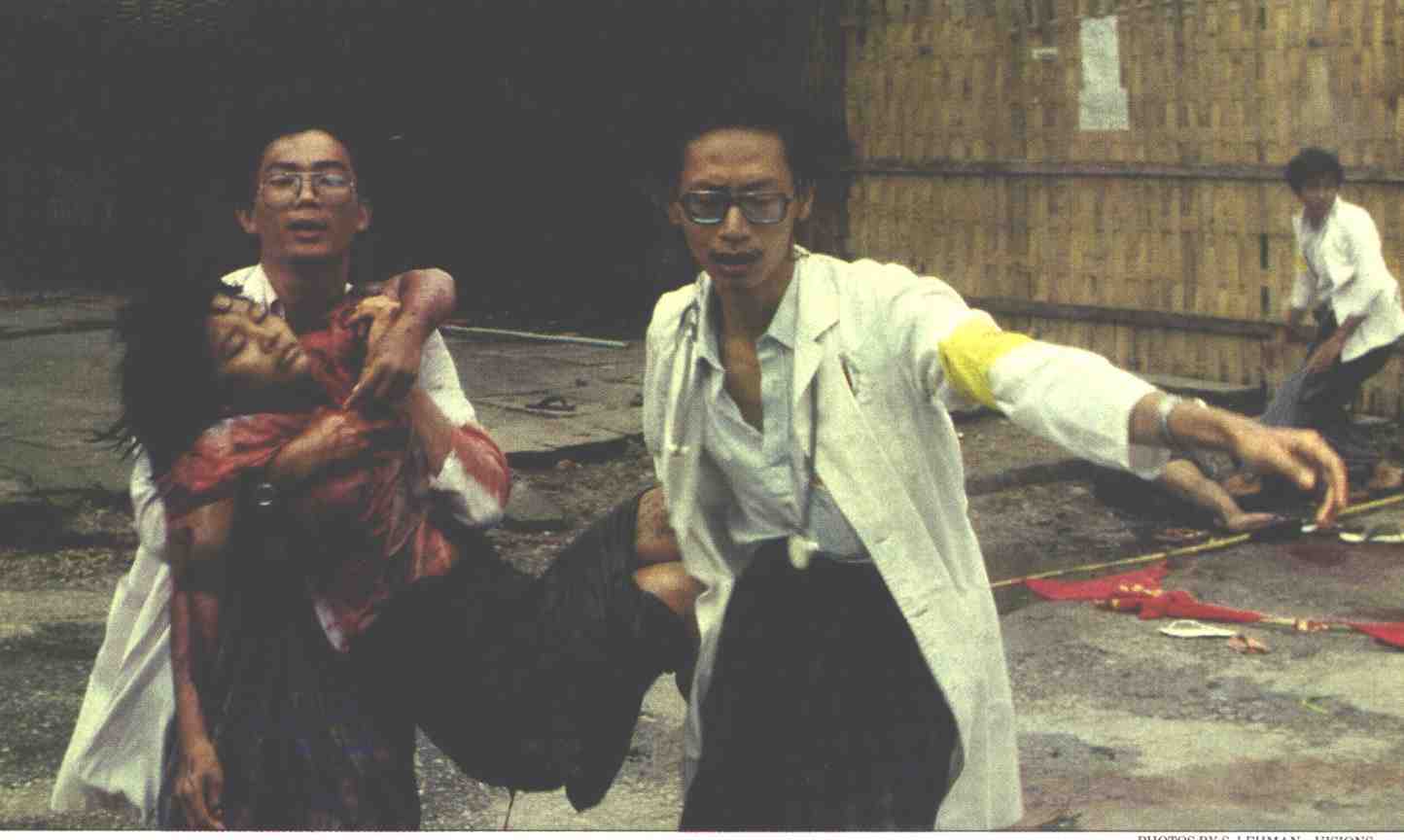
Mourners carried the bundled corpse slung between bamboo poles. Together with more than 30 others, the dead man had been gunned down by Burmese troops when hungry residents were discovered looting a biscuit factory in an impoverished neighborhood of Rangoon. "Suddenly three truck loads of soldiers pulled up and started shooting everywhere," said 17-year-old Soe Kyaw Naing. "We ran and ran and so many were killed." The young man stared at a muddy grave where more than a dozen victims already lay buried. "We have no food; we ha e no money; we have no democracy," he told me softly. "Isn't there something your government can do?".
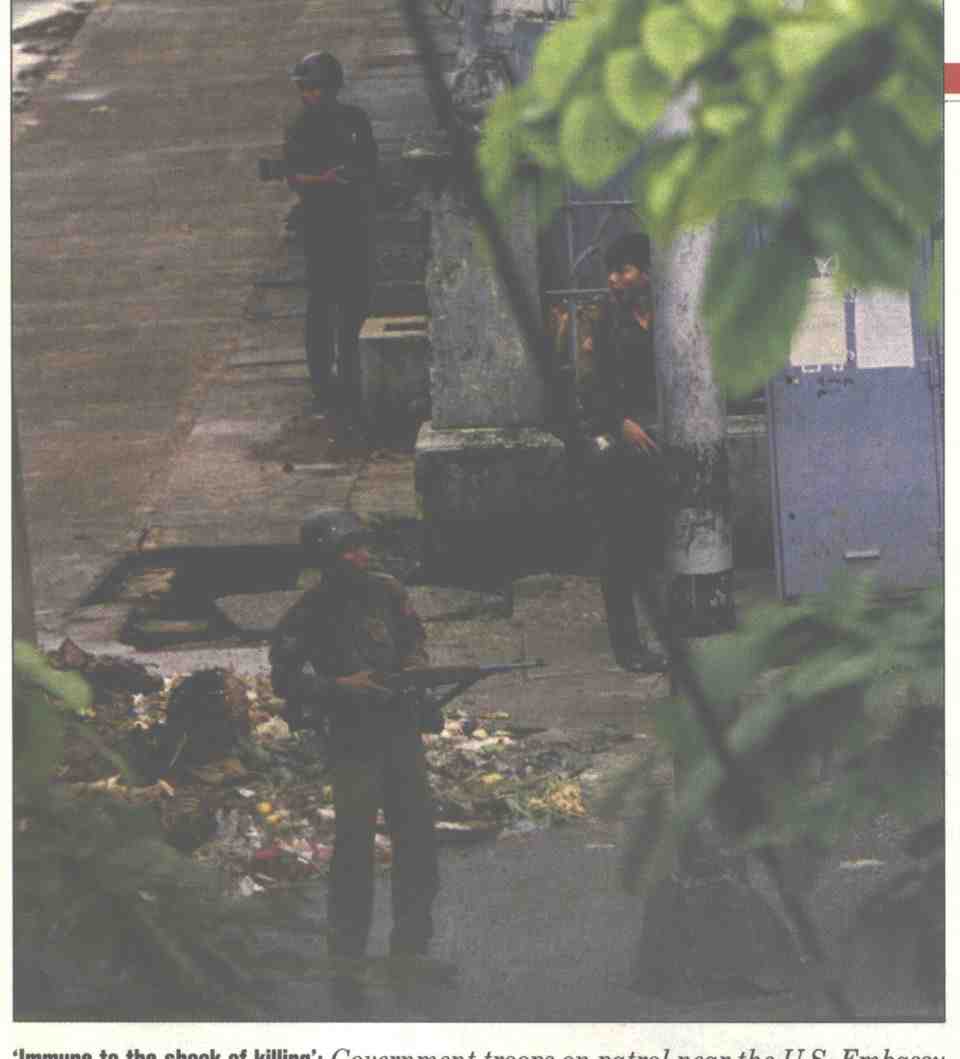
In Rangoon, I watched some of the frenzied blood letting triggered by the military takeover in the early hours of last week. When thousands of demonstrators gathered Monday in front of the U.S. Embassy and the Sule Pagoda, government troops open fire from nearby rooftops. Fighting quickly spread to other areas of the city. While residents erected roadblocks from felled trees and corrugated metal sheets, newly recruited group of urban guerrillas attacked government troops with iron arrows and sharpened bicycle spokes known as jinglees. Some defiant citizens stormed police stations and armories, fighting off soldiers with captured guns.
The government responded with calculated brutality. Using the tactics of an army of occupation, soldiers cleared away barricades, threw up mobile checkpoints and conducted house-to house searches for suspected protest leaders. All the while, they never hesitated to fire at anyone who seemed to oppose them. By the weekend, the suppression campaign had imposed atleast a veneer of normality on the Burmese capital, though there were reports of continuing strife in the nation's second largest city, Mandalay.
No return: The cost of that repression was close to unbearable: opposition leaders, doctors and diplomats estimated that up to 1,000 had died in Rangoon alone, though the total would probably continue to rise. Another casualty was any hope that the government could cure the economic mess that had sparked the popular uprising in the first place. "Do they think they can shoot people into going back to work?" demanded opposition leader Aung San Suu Kyi, the charismatic daughter of Burma's late independence leader Aung San. "We've reached the point of no return."
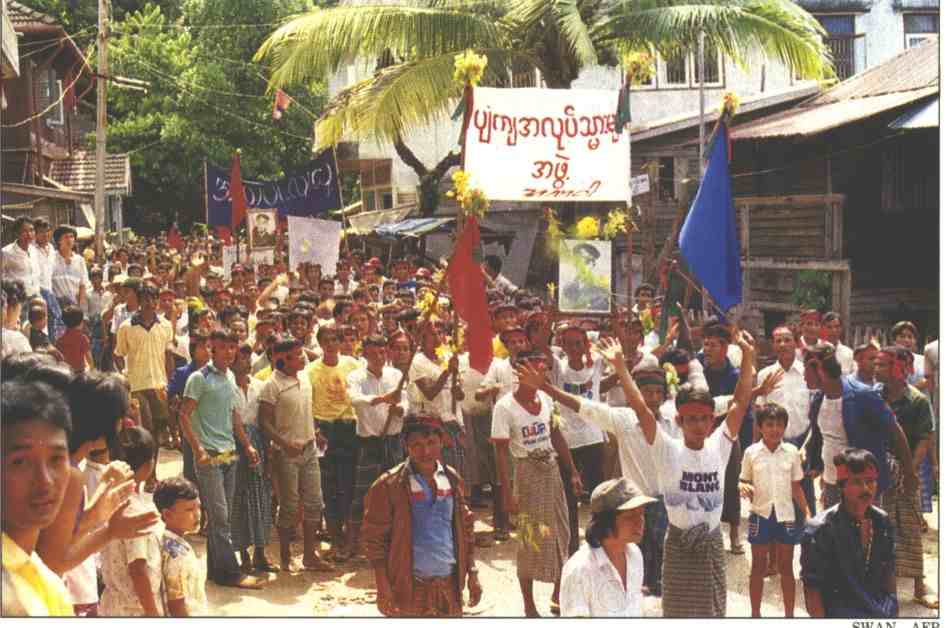
Western governments feared the violence would take a long time to subside. As the death toll mounted, Washington joined other governments in arranging the evacuation of all embassy dependents in Burma. Meanwhile, the U.S. State Department called on Burmese military authorities to "immediately...stop shooting at demonstrators" and to begin discussions with the opposition about "an early transition to multiparty democracy." In a token gesture of its disapproval, Washington also announced it was discontinuing its negligible foreign aid to Burma "until conditions permit a resumption." American diplomats did not expect that to happen any time soon. "What seems likely," said one State Department official, "is that [the military] will be able to establish control not only over Rangoon, but over the rest of the country as well. That will likely lead to a period of of stagnation of the same sort we've seen before. Then we'll have another explosion, but it will come relatively sooner and with more bloodshed. There's nothing cheery on the horizon, unfortunately."
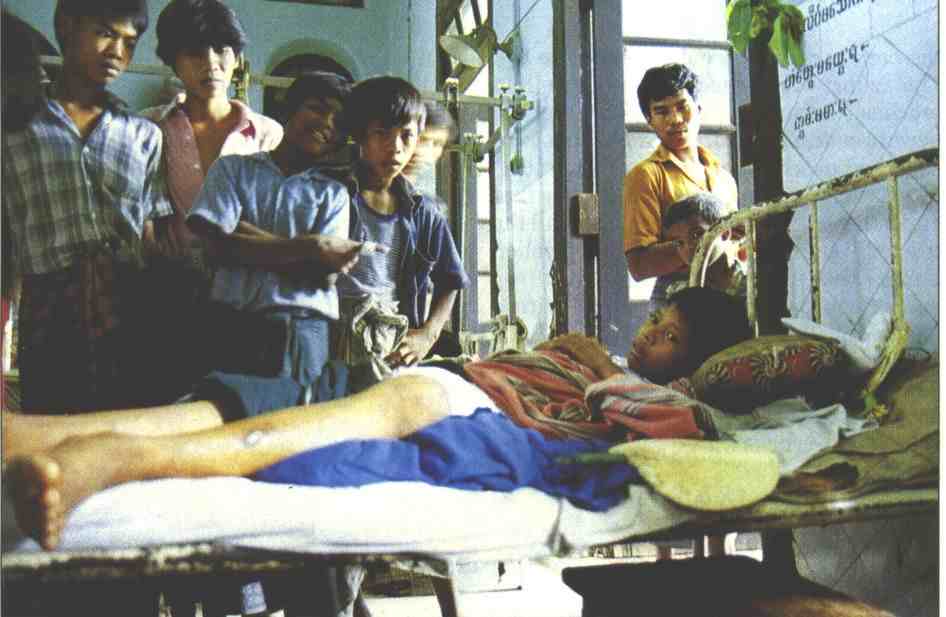
What the opposition had failed to take into account was the tenacity of the Burma Socialist Program Party (BSPP) dominated by Ne Win, Burma's absolute ruler for 26 years (box). Last July, following months of increasingly violent protests, Ne Win startled the nation by seeming to abdicate his power. His successor, Gen. Sein Lwin, was forced to step aside after only 17 days as president when government troops open fire on unarmed demonstrators, leaving up to 3,000 dead. That should have been a warning, but the opposition saw it as an opportunity, instead. Protesters hit the streets in even greater numbers when Maung Maung, the new civilian president, promised to hold a referendum on transforming Burma from one-party rule to multiparty democracy. Maung Maung quickly capitulated, announcing that a referendum was unnecessary and that multiparty elections would be held within the next three months. Even that was not enough for the opposition, which demanded that Maung Maung resign in favor of an interim government that would supervise fair and free elections. Sensing that "the administration [was] on the verge of dissolving itself," as a source close to Muaung Maung put it, the military felt it had to act.
Status quo: The takeover stunned opposition leaders and even members of the BSPP. Learning of the coup, one of the most senior members of the Maung Maung administration told a Western diplomat: "The military has dug itself a big grave. Now all I can do is pray for the Burmese people. " According to a source close to top officials, between 600 and 700 BSPP members were under de facto house arrest, their loyalties considered suspect by the new batch of military rulers. Among the detainees were Maung Maung himself and several dozen members of the Air Force and Navy who may have exhibited signs of sympathy with the protesters. Despite those detentions, some foreign analysts saw the coup as an attempt by the military to restore the previous status quo. The military had always called the shots in the BSPP, noted a longtime resident of Rangoon. Now, he added, "the Army is shedding its party cover just like a Snake sheds its skin."
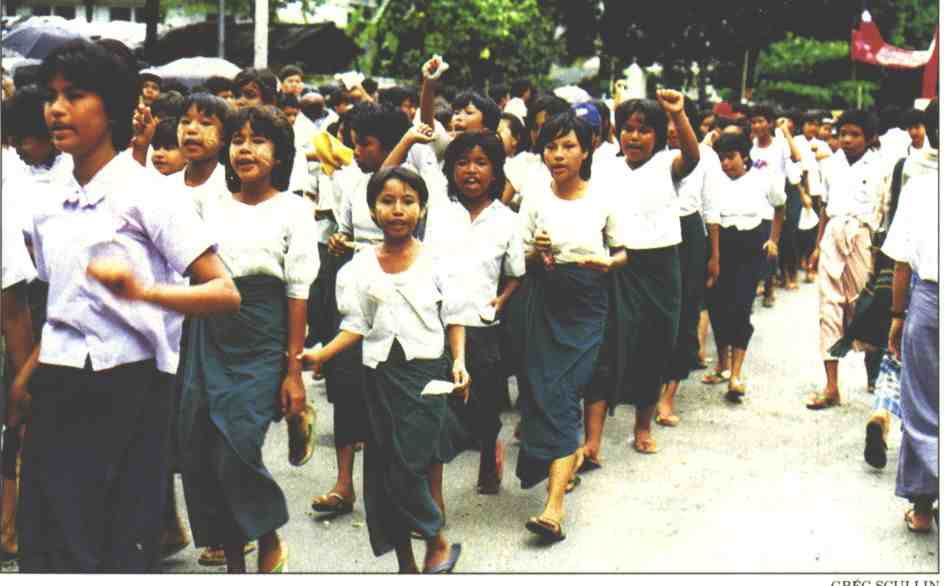
Although the coup was ostensibly directed by Defense Minister Saw Maung, few foreign diplomats doubted that it was Ne Win who was actually running the show. "There was a time when he tried to disengage from day-to-day affairs," said one Western ambassador, alluding to Ne Win's resignation last July. "But once his minions hit trouble, they were like little kids running to mommy." Ne Win appeared to be using again the blueprint of the 1962 coup that brought him to power. Now, as then, the takeover appeared to be so meticulously planned that military authorities were able immediately to appoint officers to supervise fire prevention, water distribution and other critical community services in every ward of the country.
The coup had been in the works for weeks. Officers had long complained that the demonstrations were directed by communist guerrillas who have been battling the central authorities in remote areas for years. However, the actual decision to move may have been precipitated by a confrontation by the day before the coup occurred. Speaking to a group of foreign military attache, Brig. Gen. Khin Nyunt referred to an incident in which a group of 24 soldiers fired on demonstrators at the Ministry of Trade. Rather than fleeing, the demonstrators sough reinforcement, and soon the soldiers found themselves surrounded by More than 50,000 angry civilians who were literally calling for their heads. Only the intervention of a group of Buddhist monks managed to save the soldiers from decapitation at the hands the mob. " The Army's humiliation was seen all over the world," said Gen. Khin Nyunt in apparent reference to foreign news coverage.
The military may also have been concerned by hints of erosion within its ranks. Over the past six weeks Western diplomats had watched up to 6,000 low-level soldiers joining the antigovernment protests. Rumors of plummeting morale led to speculation that even the heads of two of country;'s nine regional military commands might be softening in favor of the protesters. "But so far, when theyre told to shoot, they shoot," said a Western ambassador, shaking his head. One Asian military attache attributed that obedience to the Army's long running war against More 19 armed ethnic insurgencies since Burma became independent of Britain in 1948. "Burmese soldiers are immune to the shock of killing after four decades of it," said the attache. "My soldiers would be reluctant to pull guns on the public, but for the Burmese it's nothing."
Under fire: Last week,that ruthlessness was on full display. While combat-hardened soldiers patrolled neighborhood streets, marksmen were said to be hiding in government buildings. Indeed, when photographer Steve Lehman and Were crossing a street on onday afternoon, we were sniped at by a group of soldiers, luckily from more than a block away. In the rough-and-tumble neighborhood of North Okkalapa, where suspected government agents had been beheaded earlier this month, eyewitnesses said that soldiers carried lists of important student activists. When several were found in house-to-house searches, two were dragged into the street and shot, apparently as a warning to others. Civilians could draw gunfire if they behaved suspiciously or were simply in the wrong place at the wrong time. Much of the bloodshed was indiscriminate: the casualties included pregnant women, pre-teenage boys and girls and bystanders, such as two sugarcane vendor who were killed near the American Embassy.
As the military saw it, nearly a year of peaceful protest had suddenly blossomed into armed insurrection. But protesters armed with jinglees, samurai swords and sharpened staves were no match for soldiers armed with G3 rifles, to say nothing even more deadly instruments of war. "Now people are fighting back," said a Western diplomat early in the week, "and the government is using heavier weapons such as machine guns, monors and grenade launchers."" According to some reports, government snipers had fired mortars from rooftops at targets on the street, a method of assault which the diplomat compared to "using a bulldozer to kill ants."
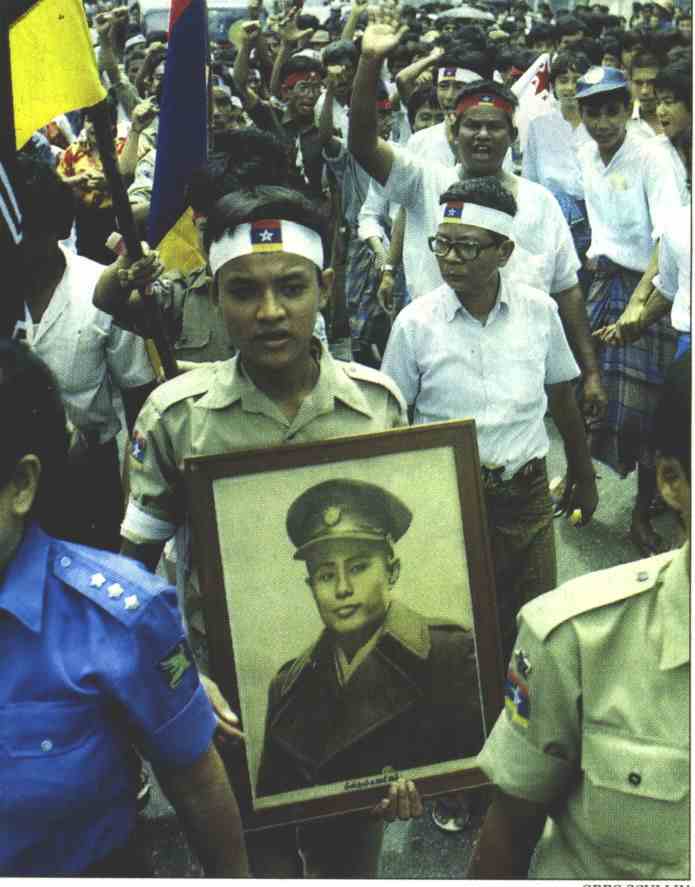
the full extent of the carnage may never be known. Soldiers hurriedly cleaned bodies from the streets, carting htem off in military trucks for swift and annoymous disposal. Masses of corpses were cremated at Rangoon's Kyandaw Cemetery, a gangster-controlled necropolis were prostitutes, pimps and drug traffickers ordinarily ply their trade. Witnesses at the cemetery said they heard the cries the shooting victims who had been brought to Kyandaw while they were still alive-- and were cremated along with the corpses.
Helter-skelter: Wandering through the dingy wards of Rangoon General Hospital, I saw victims with mangled limbs, chest wounds and legs in blood-stained casts. In the emergency ward, gunshot victims writhed on rusting gurneys, dripping blood onto the grimy floor. Undersupplied in the best of times, the hospital was running desperately low on blood and plasma. It was also running short of morgue space. I saw 30 bodies piled helter-ske;lter in the refrigerated vault. some victims looked as if they were sleeping, but most had vicious wounds. One man was missing the top of his head; a 10-year-boy had a bullet hole in the middle of his forehead.
Doctors and patients told tales of the military's callousness. Doctor reported that soldiers had fired on medical personnel as they attempted to rescue shooting victims. A 38-year-old merchant claimed he was shot as he loitered at the stall of a betel-nut vendor on Tuesday morning, "There was no marching or shouting, just people going about their business,"said the man, whose pelvis was shattered. "The soldiers just walked down the street shooting all the way."
While the military was hardly likely to win the affection of the Burmese people, the commanders were determined to try. The effort contained some Orwellian touches, including a Tuesday-evening news broadcast warning soldiers "not to be rude and overbearing" and to "communicate patiently with the people." "Does that mean they should smile when they pull the trigger?" snorted one civilian in disbelief. Earlier that afternoon, a military convoy had driven past the Strand Hotel with a loudspeaker blaring the message: "If you remain calm, if you don't fire jinglees at the soldiers, we will not shoot you." Troops in the backs of the trucks waved gaily at passers-by.
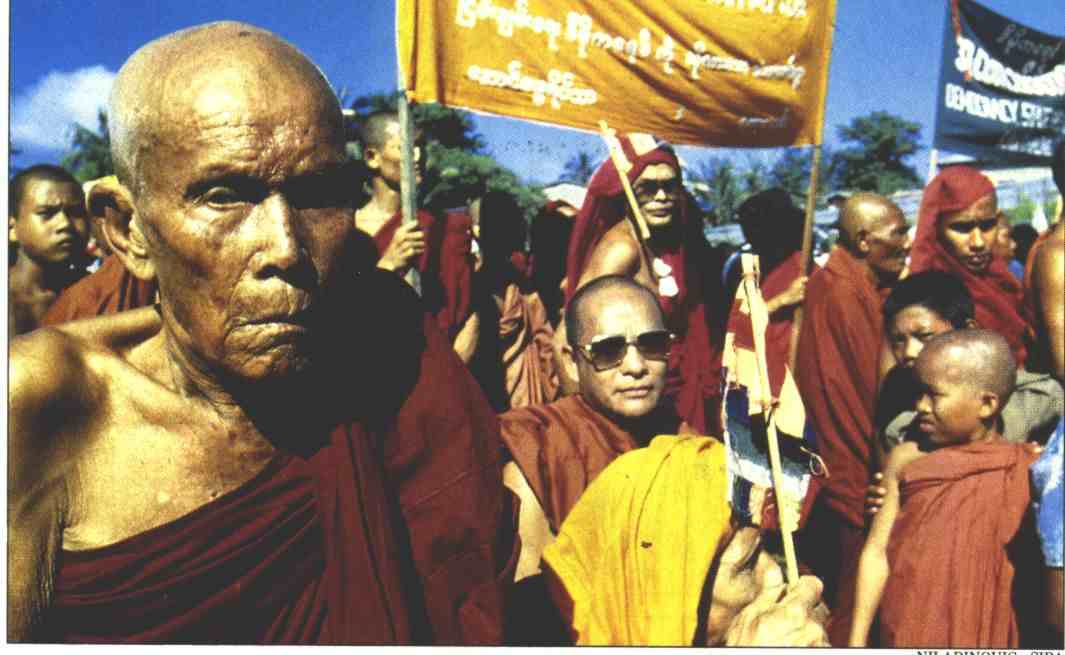
Rapid transition: Equally unconvincing was Saw Maung's pledge to hold "free and fair multiparty elections as soon as possible." That possibility was unlikely to arise soon. In what appeared to be a conciliatory gesture, the government publicized a call by the Buddhist clergy for negotiations between the junta and its opponents. Opposition leaders believed that any such talks could easily weaken their hold over students and other more radical protesters. The ideal solution, foreign diplomats maintained, would be a rapid transition to a largely civilian government in which technocrats and opposition figures were well represented. Such a move, however, would likely be rejected by the generals and colonels who suddenly found themselves with More authority than ever. "Now they have whole ministries to play with," warned an Asian military attache whose own country has had its share of military rulers. "dialing back on this may be like try to put the genie back into the bottle."
The future of the opposition may now depend on radical students and the country's 1.2million Buddhist monks. While badly hurt by the military crackdown, students operate according to a class underground cell structure in Rangoon and Mandalay. They have also developed some primitive but effective military tactics.
In Mandalay, for example , a group of student guerrillas drove a herd of water buffaloes into an Army encampment and, hiding behind the animals, attacked the soldiers with slingshot-fired jinglees. The soldiers returned fire, killing five water buffaloes, but that the attackers managed to escape. Moreover, according to reports reaching Bangkok, key student leaders have fled into the countryside, where some of them have established contact with non-Burmese ethnic insurgents operating along the border with Thailand. Some 60 Burmese students were reported to have fled to the border sanctuaries of the Karen guerrilla group, where they asked for refuge and military training. But the rebel groups, which have only limited military supplies, were reportedly reluctant to provide the students with arms.
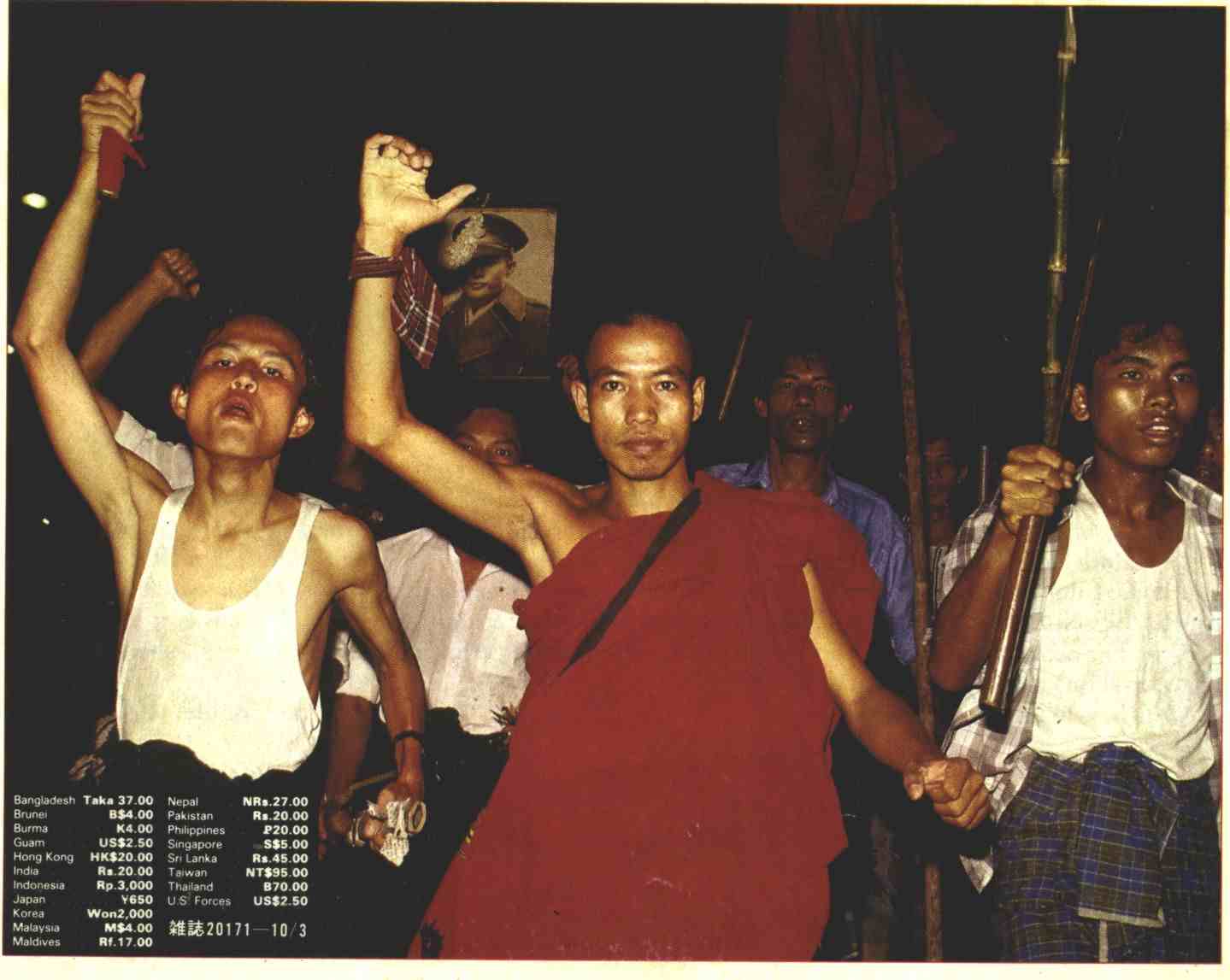
Basic services: the Buddhist clergy, meanwhile, may serve as a focus for more open opposition. As the capital lurched into anarchy in the weeks preceding the coup, monks took over the basic services that had been abandoned by the rapidly unraveling Maung Maung administration. They organized themselves into teams that specialized in police work, sanitation, communications and transportation. Even the military seems in awe of the monks. Shoes are forbidden in their monasteries,much less automatic weapons. Now, without challenging the military overtly, the monks are expected to continue to offer pro democracy groups sanctuary and support.
The question is how far the opposition would dare to go. The Burmese people seem to feel it is the first real hope of democracy in a generation; they are unlikely now to lay those aspirations aside. Burma may now return to repression and sullen economic decline -- or face the agony of a protracted civil war. Last week the military seemed guided by the Maoist maxim that political power grows from the barrel of a gun. But amid the carnage and rebellion that swept the streets of the capital, that notion was beginning to look tragically naive.
NEWSWEEK/OCTOBER 3, 1988.



